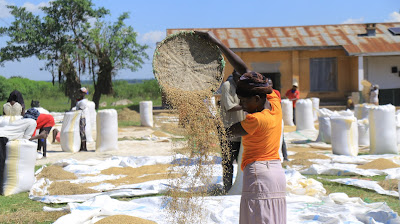Doho Irrigation Farmers’ Cooperative Society upgrades their rice storage facility
Introduction
Doho Irrigation Farmers’ Cooperative Society (DIFACOS) are ACDP cohort three matching grantees. This seven year old Cooperative Society is under the mandate of Ministry of Water and Environment in conjunction with the Ministry of Agriculture and replaced the management committee in 2014. Butaleja district where this scheme is found a potential rice growing area and has water throughout the year supplied by the three rivers of Manafa, Mpologoma and Namatala. DIFACOS members are all rice farmers and are enrolled in the e-Voucher system.In 1997, the infrastructure at Doho irrigation rice scheme was washed away and this led to government intervention of improving the irrigation scheme to control the flood waters. As a result 98% of the farm plots receive water for irrigation.
Matching grant
In 2021, DIFACOS became beneficiaries of a total grant of UGX 373,134,328 with government contribution of 250 million and the cooperative co-financing of UGx 123,134,328. This funding will be used to acquire a modern rice mill for production of high quality rice, that will later be branded and packaged for the local and export market.Mr Wasika Yubu, the chairperson stated that, the cooperative had already commenced work on improvement of the storage facility where the rice milling machine would be housed.
At the time of this interview, the cooperative had as part of their 33% contribution, installed air conditioners, translucent iron sheets for more lighting, expanded the windows, installed water tanks, built more toilets and planted trees as part of the Environmental Social Safeguards.
“We have been longing for this machine because we had started the bulking process but because of the poor quality of the machines we had, we could not produce good rice that would enable us compete favorably in the market. We have been selling our rice here in Mbale”, Mr Wasika said.
“If we keep improving, we believe we shall soon stop importing rice from other countries because what we have here is enough to feed the whole country and export too”.
The government is already constructing Doho 2 for more rice production and the scheme is at almost 90% completion.
 |
| Cooperative members manually clean, sort and pack rice for the market |
Benefits
Mr Wasika, stated that Butaleja district had never accessed any relief in form of food, since it is a food basket. He continued to say that, there was a year when people from Pallisa, Buddaka, and Tororo migrated to Butaleja district because of rice farming.
Dalson, Malingahaperi, a farmer and member of the cooperative re-echoed that, since he started farming in 1976, and joined the association when it was still a group he has never looked back. In 2003, they were taken for training to Kilimanjaro, Tanzania, and later to Tokyo. “When I came back, I started practicing line transplanting so that the plant can have enough for easy weeding and use of a machine”. Plants need sunshine and wind, planting the rice plant in lines makes it easy for the wind to pass through, said Dalson.
Lead farmer- Dalton in his rice demo field- Doho 1 rice scheme
Then ACDP came and we were given a new variety of rice called ‘WITA 9’. Before we were planting K5, K23, K98, K85.(K means that seeds are from Kibimba). WITA 9 is now a popular variety that has been adopted by most farmers because it is high yielding, early maturing and it is a short plant.
ACDP has given me the seed for planting, fertilizer, and tarpaulin for drying rice. I was given this demonstration site to farm and influence other farmers. Application of fertilizers “Urea” boosts the yields. Even if we paid a certain percentage (33%) to receive help, ACDP has given us much more than what we put in, we have been heavily uplifted.
Mr. Malwa Augustine, another cooperative member, noted that there had been an improvement in the yield after they started putting into practice the farming techniques they had been taught, like fertilizer application and spraying of the plants from pests.
The DAO Weere Stephen told us that ACDP had commercialized and created a demand driven approach to technology dissemination and adoption. “After the ACDP intervention, farmers now call to ask for the WITA 9 variety, to plant an acre a farmer needs 10 kgs, so Iam in touch with a number of seed suppliers”.
Research extension linkages
According to the DAO, lead farmers had been trained under the “Rice Musomesa program”. These lead farmers are expected to train other farmers. Research under NARO/JICA where farmers are producing seed that is sold to companies are ongoing. Farmers’ demo sites are side by side with the demo sites for ease of learning as they also multiply the WITA 9 seed, supply other farmers under ACDP.

NARO/JICA Demo at Doho1, adjacent is the farmer's demo field



Comments
Post a Comment